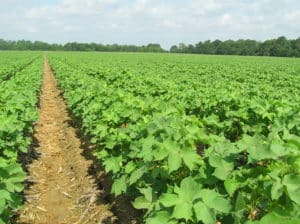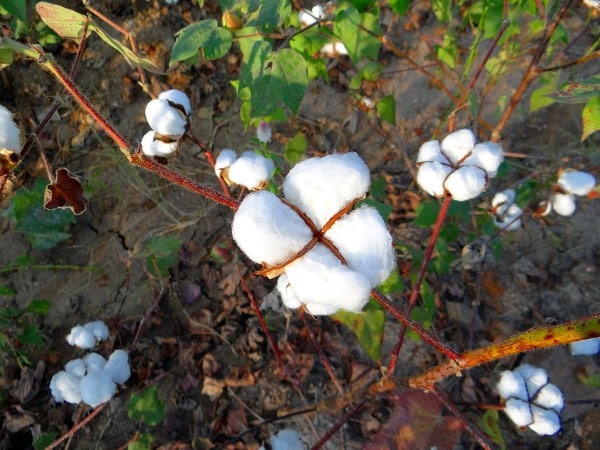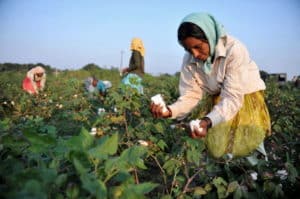Cotton Farming Detailed Information Guide:
The following content is about Cotton farming techniques, cotton plantation methods, cotton seed rate, harvesting and yield of the cotton crop.

Introduction of Cotton:
Cotton is one of the most important fibers and a cash crop of India and plays a dominant role in the industrial and agricultural economy of the country. Cotton is the most important fiber crop not only of India but of the entire world. It provides the basic raw material (cotton fiber) to the cotton textile industry. Cotton in India provides a direct livelihood to 6 million farmers and about 40 -50 million people are employed in the cotton trade and its processing. Indian cotton production is heavily associated with the intensive use of hazardous pesticides. Data reveals that Cotton cultivation in India consumes 44.5% of the total pesticides used in the country. In addition, cotton is a water-thirsty crop and around 6% of the water for irrigation in India is used for cotton cultivation. Its seed (binola) is used in the vanaspati industry and can also be used as part of fodder for milch cattle to get better milk.
The factors for the growth of Cotton in India are:
- Large favorable fertile Ganga Delta region,
- Plenty of cheap labor,
- Introduction of insecticide to kill Boll Weevils,
- HYV seeds like Sujata, Bharati.
- Introduction of favorable Fertilizer is good for the production of cotton.
Gujarat, Maharashtra, Punjab, Uttar Pradesh, Madhya Pradesh, Tamil Nadu, A.P. are the principle cotton producing states in India.
Types of Cotton:

a) Long staple cotton:
It has the longest fiber whose length varies from 24 to 27 mm. The fiber is long, fine and shining. It is used for making fine and superior quality cloth. Obviously, it fetches the best price. There has been rapid progress in the production of long-staple cotton since Independence. About half of the total cotton produced in India is a long staple. It is largely grown in Punjab, Haryana, Maharashtra, Tamil Nadu, Madhya Pradesh, Gujarat, and Andhra Pradesh.
b) Medium staple cotton:
The length of its fiber is between 20 mm and 24 mm. About 44 percent of the total cotton production in India is of the medium staple. Rajasthan, Punjab, Tamil Nadu, Madhya Pradesh, Uttar Pradesh, Karnataka, and Maharashtra are its main producers.
c) Short staple cotton:
This is inferior cotton with fiber less than 20 mm long. It is used for manufacturing inferior cloth and fetches less price. About 6 percent of the total production is of short staple cotton. U.P., Andhra Pradesh, Telangana, Rajasthan, Haryana, and Punjab are its main producers.
Read: Organic Cotton Production.
Climate and Soil requirement for Cotton Production:
The hot and moist climate is ideal for cotton farming. The climatic condition for cotton cultivation is mentioned below :
Seventy percent of cotton is rainfed. Clear sunshine & proper moisture level during boll formation is required. Moisture stress from 60 days to 120 days directly reduces the yield. More sunshine and warm humid climate favor the growth of the cotton crop. The low temperature at the boll opening creates a problem in the harvest.
- Temperature: 25°C is ideal for cotton cultivation.
- Rainfall: 150 cm to 200 cm rainfall is essential for cotton farming. Moisture in the wind is necessary.
- Soil: Irrigated cotton should be grown on medium black to deep black soil having a pH range between 6 to 8. Saline soils are not suitable for cotton cultivation. Soil should have proper drainage. The depth of soil should not be less than 20 to 25 cm. It is advised to go for a soil test before cultivating the cotton.
Soil Preparation in Cotton Plantation:
In Cotton production, the preparation of a good flatbed is very important. This can be done by plowing & disc harrowing. Plowing should be followed by harrowing operation making the fine til soil particle. For an advanced method of drip irrigation soil should be well prepared. Add 4 to 5 tons of well-decomposed FYM or compost before the last harrowing. In the soils having termites or white grub, add 750 to 1000 Kg/ha of Neem cake along with FYM.
Essential Crop Rotation for Cotton Crop:
Cultivating cotton in rotation method is very important. Cotton should be followed by crops like hybrid sorghum, sugarcane, maize, banana, etc. Cotton should not be followed by cotton as it increases pest and disease problems.
Improved and Hybrid varieties in Cotton
For irrigated cotton, the varieties from G. hirsutam species should be preferred. Also, hybrids of Hirsutam x Hirsutam or Hirsutam x Barbadense may be preferred. There is a number of varieties that are recommended for growing in India.
Region wise varieties in India are:
- Northern Region : LH1134, LH1556, H-4, H-6, MECH-1 etc.
- Central Region : H-4, JKHY-1, H-6, PKV HY-2, NHH-44, MECH-1,
SHAKTINATH, RCH-2 - Southern Region : DCH-32, Varlaxmi, Savita, Suvin, HB224, MCU5 etc.
Selection of Seeds for Cotton Planting:
Only certified and tested seeds should be used for irrigated cotton. Delinted seed is preferred. 2.5 to 3 kg of seed per hectare should be used. Seed should be treated with Thiram or Bavistin. Extra seeds should be uutilizedfor gap filling. Raise the seedling for gap filling in polybags. Fill the gaps during the rainy season. Plantation in cotton farming between 7 to 8 thousands per hectare is optimum.
Plant Spacing of Cotton:
Under Micro Irrigation (MIS) Crop geometry may vary to economize the drip system. However optimum plantation per hectare of irrigated hybrid varieties is considered between 7000 to 8000 per hectare. Considering the soil type & varietal characters, spacing in pair row planting can be 2.5′ x 5′ x 5′ or 3′ x 4′ x 3′. The spacing of 4′ x 3′ (Heavy Soil) & 3′ x 3′ (Medium Soil) is adopted in Single row system.
Read: Bark Grafting Techniques, Ideas.
Best Planting season for Cotton:
Cotton should be planted before the onset of monsoon so that desired vegetative growth of the plant is achieved. Planting season varies in various regions.
Irrigation requirement in Cotton Production:
Drip Irrigation is the most effective way of watering in cotton farming
Main advantages of drip irrigation :
a) Drip Irrigation increases the yield of cotton. On all India basis a yield increase of 27% is recorded (INCID,1994). There are individual farmers cases where yield was doubled by drip irrigation when compared to the yield obtained under furrow/flood irrigation methods. Research into the reasons for such yield increases under drip systems has shown that – yield increases as the interval between water application is decreased even if the total amount of water applied is unchanged. During heavy fruiting mild water stress associated with intermittent irrigations triggered deterioration of the root system which is irreversible. Only high frequency, low-intensity drip irrigation can prevent such cyclic water stress.
b) Drip irrigation makes it possible to grow cotton in all types of soils. Even in light or shallow soil in which water storage is inadequate to supply the crop over an extended irrigation cycle as is the case with furrow or flood irrigation, drip irrigation provides an opportunity to raise a good, high yielding cotton crop.
c) Because it eliminates intermittent water stress, drip irrigation allows the crop to approach its production potential for more days of the season thus resulting in higher yields.
d) Drip irrigation is suitable in any type of land/soil management system – flat, ridge and furrow, and bed and furrow systems.
e) Early planting and establishment of the cotton crop are important as part of IPM and for high yields. Drip irrigation proves to be a boon in such situations, especially when the monsoon plays truant.
f) Drip irrigation results in early and uniform maturity of the crop and improved quality of kapas.
g) Because of the uniform distribution of water to each plant in the field the growth of plants will be more uniform.
h) Application of water close to the rootzone keeps weed growth under control. It also reduces the incidence of pests and diseases as the foliage is not wetted and the dry canopy conditions are maintained.
Intercultivation Operations of Cotton:
Timely weeding or use of weedicide will minimize the weed population. If soil preparation is properly done before sowing, then inter-cultivation with hoeing etc. should be minimum in drip irrigation. In pair row, planting interspace between two pair rows can be inter-cultivated by small implements. Mulching can be done in irrigated cotton.
Fertilizers and Fertigation of Cotton Crop:
The application of major nutrients like N, P, K and trace elements like iron, boron, magnesium, sulfur, zinc plays a vital role in cotton production. Balanced and timely application K gives a better result. Though cotton does not appear to be an exhaustive crop, when grown intensively, high yielding varieties need an abundant supply of available nutrients. Nitrogen, Phosphorus, Potassium, and Magnesium are the major nutrients essential for cotton. In India, experiment data reveals that on an average 100 – 125 Kg N, 60 – 75 Kg of P2 O5, 80 Kg of K2O per hectare are recommended. However, it is always advisable to calculate the N, P, K doses after soil analysis report. Under traditional fertilizer application, the entire dose of P & K is added as basal dose and Nitrogen into 3 – 4 split doses. Traditional fertilizer is to be placed well deep into 4 – 5 cm, below the soil near the wetted area of the dripper.
Read: Pig Fattening Feed Guide.
Harvesting and Yield Of Cotton:
Cotton can either be picked by hand or by machines. Manual picking is slow but better preserves fiber characteristics of cotton. Boll opening is the first action on the fiber which pushes fibers from the place where they were embedded for weeks before being exposed to the external conditions. The boll opening action is gentle and thus has no effect on the fiber quality. However, a longer stay of the open bolls in the field may change the color and also make the fibers shrink, thus affecting the three most important fiber characters, i.e. length, strength, and micronaire. One character may be affected more than the other if there is a frequent dew. Such an effect cannot be eliminated as all bolls do not open at the same time and some open bolls have to stay in the field for days and sometimes even weeks. In the case of hand picking, it is possible to pick open bolls at frequent intervals, and weather effects on the fiber, after bolls have opened, can be minimized. In China (Mainland) this effect is minimized as land holdings are so small that the majority of the growers who have planted cotton on about 1/10th of a hectare, can go many times to the field to pick few open bolls. In slightly bigger plots, fiber quality is preserved through a number of pickings during the season. 3-4 pickings/season are very common in many countries where cotton is hand packed.

Cotton yield depends on the management practices with the adoption of advanced technology for growing cotton. The cotton crop can give 50-60 quintal/ha yield of kapas under drip irrigation.
Bottom Line of Cotton Production:
The initial Investment in cotton farming is high compared to other crops but profits also very high in cotton farming.
Read: How to Make Liquid Fertilizers at Home.
Please give the detail of recent diseases ,there prevention and chamicals application for cotton.
hello,
I would like to know about when is cotton cultivated in india, especially gujarat.
what is the sowing season and when is it harvested
In Gujarat, in fully irrigated fields, planting of cotton starts in month of May, while rainfed/partially irrigated fields, sowing in with onset of monsoon, somewhere in June month. Cotton is 150-180 days crop. Harvesting starts at Nov end
What is the water requirement per hectare per day for growing cotton.